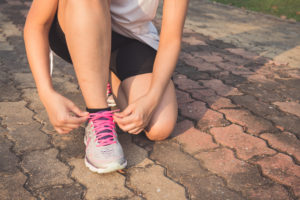Posterior Tibial Tendon Dysfunction (PTTD) describes the damage to, and inflammation of, the posterior tibial tendon, one of the major supporting tendons of the foot that plays an important role in our ability to walk, holding up the arch and supporting the foot as we walk. As the name suggests, the posterior tibial tendon travels down the back of the tibia (shin bone) and crosses to the inside of the ankle, behind and below the bony bump (medial malleolus) to attach to multiple sites at the bottom of the foot. PTTD is often referred to as Adult Acquired Flatfoot as it is the most common cause of flat feet developed in adulthood. This is because damage to the tendon impairs its ability to support and stabilise the arch.
 PTTD
is an overuse condition, caused by overloading and straining the posterior tibial tendon past what it can safely handle, resulting in damage
and inflammation. Contributing factors to the development of PTTD can include:
PTTD
is an overuse condition, caused by overloading and straining the posterior tibial tendon past what it can safely handle, resulting in damage
and inflammation. Contributing factors to the development of PTTD can include:
PTTD often affects one foot, though can develop in both. Without effective management, the symptoms of PTTD tend to progressively worsen resulting in a partial or even complete tear of the tendon. PTTD can be characterised into 4 stages of progression. Symptoms of PTTD can include:
Early intervention is recommended to stop the progression of painful symptoms and further damage to the posterior tibial tendon. The PRICE principles (protection, rest, ice, compression and elevation) can be used initially to help reduce painful symptoms. Treatment then needs to focus on addressing the cause of the PTTD and may include:
If left untreated, symptoms can leave you with not only flat feet but the inflammation and damage of surrounding structures, particularly at the ankle, as well as conditions such as arthritis that can make daily activities like walking painful.

We’ve all had those days — you come home after hours on your feet, kick off your shoes, and notice your ankles look puffier than usual.
Swelling in the feet, ankles, or legs (known medically as edema) isn’t always a reason to panic. It can be as simple as a
salty lunch or a long flight.
But what if it’s happening more often — or seems to be getting worse? Swelling can sometimes be a sign of something more serious. Here’s
what could be going on and when to check in with your doctor.
.jpg)
Every year on October 8th, the world celebrates International Podiatry Day - a day dedicated to
raising awareness about foot health and the vital role that podiatrists play in our overall well-being.
Keeping your family on their feet and helping them to walk, run, play and exceed their goals is why we love getting up in the morning.
Ground Floor, One Health Building
122 Remuera Rd, Remuera
Auckland 1050, New Zealand
| MON - FRI | 7:30am – 6:30pm |
| SAT | 8:30am – 4:30pm |
| SUN | Some availability |
Make an Appointment
Online Schedule
Our virtual receptionist is available 24/7 to help with general questions, booking requests, and clinic information, even when our team is busy, or it's after hours.
Whether you're calling us or using our website, you'll get fast assistance any time of day. And if your query needs a personal touch, a member of our team will follow up as soon as possible.
If you’d like to see a podiatrist who speaks your preferred language, just give us a call and we’ll help you book.